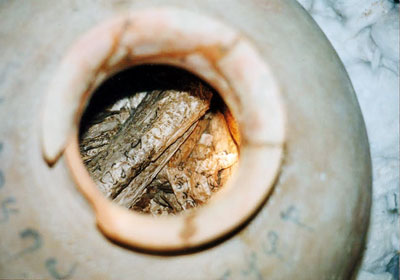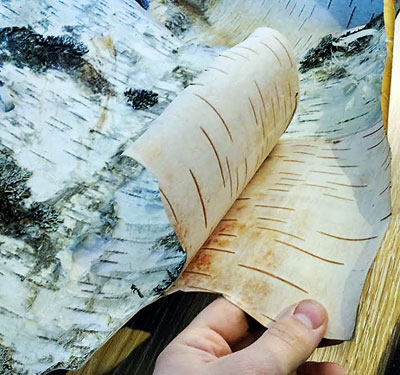Unravelling the discovery of ancient Buddhist scrolls

One of the pots with the unrolled scrolls in it
From the point of view of history, Christianity and Islam have certain advantages over Buddhism. Both Jesus and Muhammed lived in cultures where writing was well-known and widely used. Writing was almost certainly unknown in India during the Buddha’s lifetime and did not come into use for perhaps 150 years after his passing. Of course this does not mean that the Buddha’s words were not faithfully preserved. The Vedic Brahmans had already perfected techniques of oral transmission that were extraordinarily accurate and it was these very techniques that the first few generations of Buddhist monks, many of who were Brahmans, used to preserve and pass on the Buddha’s words. It is automatically assumed that writing preserves documents more faithfully than oral transmission does. But this is not so. Scribes make errors as they copy out documents, they can also add passages or delete them, and all ancient documents are full of such mistakes, additions and deletions, so much so that it is sometimes almost impossible to know what the original said. Oral transmission by contrast, particularly if it was done by groups of reciters as was the case with Buddhist text, is much more difficult to change. If a group of monks knew a text by heart and while they were chanting it together one of them tried to add or delete something, all the others would immediately notice it and prevent the text being changed. Nonetheless, modern historians can examine, date and scrutinize a manuscript, but they can’t hear something that was chanted 2500 years ago.
The oldest evidence of Christianity is a tiny fragment of papyrus with part of the Gospel of John written on it. It may date from as early as 90 AD, perhaps only 60 years after the death of Jesus. Islamic tradition says that in 634 the first Caliph had all Muhammed’s revelations compiled into what became the Quran. Tradition also says that by 650 it was noticed that there were already differences in the various manuscripts of the Quran and so the third Caliph had what he considered a standard edition prepared and all other versions destroyed. If this tradition is reliable it would mean that the Quran dates from little more than 20 years after Muhamed.
Christianity and Islam had another factor in their favour, at least as far as written evidence of their early history is concerned; the climate. Israel and the Arabian Peninsula are hot and dry, very dry; perfect environments for the preservation of fragile papyrus, paper or parchment. Consequently some very early manuscripts of both the Bible and the Quran have been preserved. The Ganges valley where the Buddha lived is by contrast hot, humid and the home of various bugs that can feed on most writing material. The oldest written evidence we have of the Buddha is King Asoka’s edict written on the stone pillar that he had erected at Lumbini in 245 BCE, about 150 years after the Buddha’s passing. This is strong evidence that there was such a person as the Buddha and it only survives because it was inscribed in stone. But unfortunately, it tells us nothing about what the Buddha taught. Until just recently, the earliest manuscripts of Buddhist scriptures date from at least 1000 years after the Buddha and nearly all of these are Sanskrit Mahayana sutras,which historians have long known were composed centuries after the Buddha, not Theravadin Pali sutras.

Sheets of thin birch bark being separated
Then in 1994 the British Museum acquired a collection of ancient birch-bark scrolls under circumstances that have not as yet been fully explained. It is thought that this is what happened. Sometime before this date, a farmer in Afghanistan was digging in his fields when he discovered several clay pots. Looking inside he noticed what looked like several old cigar butts. Thinking that he might be able to get a few rupees from some antique dealer he passed the pots to a friend who in turn passed them to someone else, until eventually they ended up in the illicit antique market in Peshawar in northern Pakistan, a clearing house for ancient artefacts being looted from Afghanistan and northern Pakistan and smuggled overseas. Exactly what happened next is even more opaque. An alert antique dealer must have noticed that the cigar butt-like objects had writing on them and were some kind of documents. He must have contacted someone at a certain foreign embassy in Islamabad who contacted a wealthy collector in London, and after a series of negotiations a price was agreed upon and the pots and their contents arrived in London.
After being carefully examined by experts it was discovered that the objects from the pots were actually ancient rolled up scrolls written on birch bark. It was also very clear that they were extremely fragile and that only the most up-to-date scientific techniques would be able to unroll them so that they could be read. The anonymous collector very generously decided to donate the scrolls to the British Museum.
It was immediately understood by the museum that they had acquired something of potentially enormous importance and so a team of scientists were assembled to try to unroll and then preserve the scrolls. Over a period of several months they were humidified to soften them and then with the greatest care gradually unrolled. Further, hundreds of tiny fragments of the scrolls were put together as one would a jigsaw puzzle, a task requiring enormous patience, and a task that is still on-going. As this painstaking job continued it was found that the scrolls were Buddhist sutras, by far the oldest ever discovered. When news of this discovery became known the press called the scrolls the Dead Sea Scrolls of Buddhism, a somewhat misleading name.
When the ancient Buddhists decided to commit the Buddha’s words to writing they found that they had a problem. What were they to write them on? They could be inscribed on thin metal sheets which would have been very durable, but as the Tipitaka is so big a book of such pages would have also been heavy and unwieldy. Parchment made out of animal skins was an option but rather inappropriate for a religion that teaches kindness to all beings. Paper had not yet been invented. And palm trees with leaves big enough to make a page do not grow in northern India. So in the end the Buddhists settled on the thin smooth bark of the birch tree, a common tree of the Betula genus.
The scrolls in the British Museum show that pieces of birch bark were pasted together so that a long strip was formed, the edges were sewn to minimize fraying and then the surface was written on using ink. When someone wanted to read a sutra he or she simply unrolled the scroll. As birch bark is not very strong the scrolls could not have been long-lasting. Archaeologists now believe that when they became tattered and could no longer be used they were not burned or simply thrown away, rather they were buried, and that is why the scrolls in the British Museum were found in pots. They had been carefully and reverently given a burial.
The British Museum scrolls are thought to date from the 1st century BCE making them the oldest Buddhist books ever found. And more interesting, they include sutras that we can read in the Tipitaka even today – the famous Rhinoceros Sermon (Khaggavisana Sutra), from the Sutta Nipata, Dhammapada verses, sutras from the Anguttara Nikaya, the Samyutta Nikaya and parts from the Abhidhamma Pitaka. This is extremely exciting and very significant because it shows that the Tipitaka as we have it today is substantially the same as what was available within perhaps 400 years of the Buddha’s passing.
An international team of scholars is in the process of studying and translating the scrolls and so far three volumes have been completed and published. The sutras are not in Pali but in Gandhari, a language spoken in northern Pakistan and eastern Afghanistan (ancient Gandhara) around the first turn of the first millennium and they are in a script called Kharosthi.
There is something about these precious scrolls that might be called, without exaggeration, miraculous. That the person who found them, no doubt a poor simple peasant, didn’t just throw them aside as useless junk; that their rough and tumble transportation to Peshawar did not destroy such fragile objects; that someone realized that they might be of value and contacted someone who knew that they were; that someone was prepared to pay out what is thought to have been a very substantial sum to acquire them; and that they were found at a time when technology existed that was able to salvage them; even 50 years ago this could never have been done; all makes one think that the devas or at least some benign force has been behind their becoming available to us.


